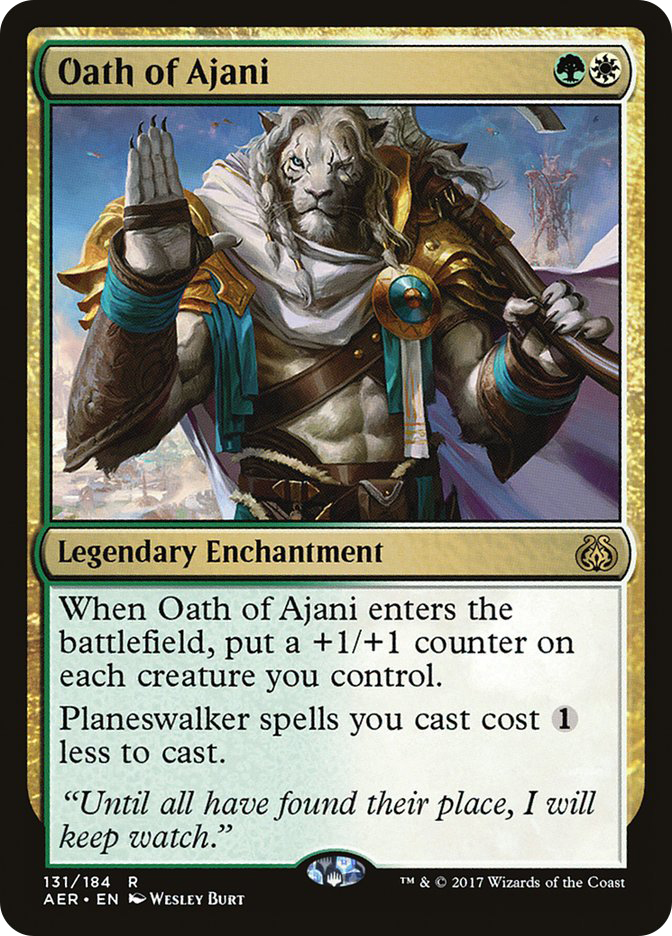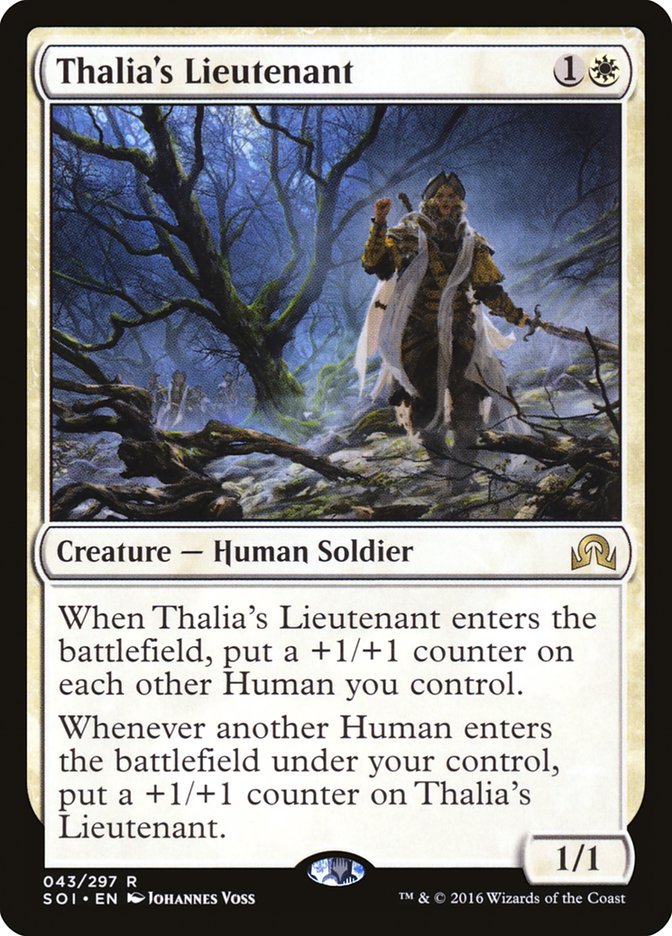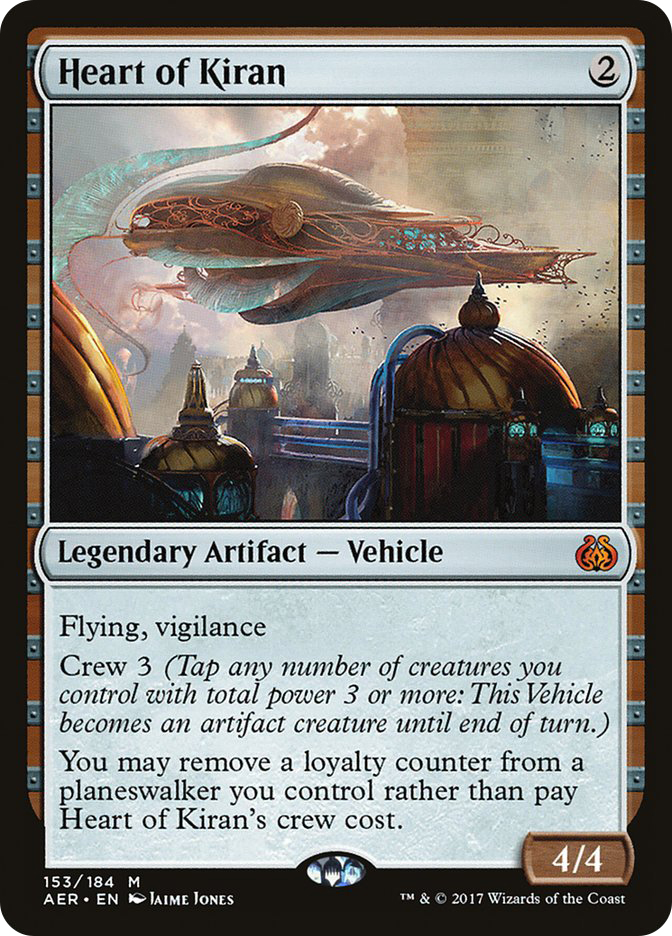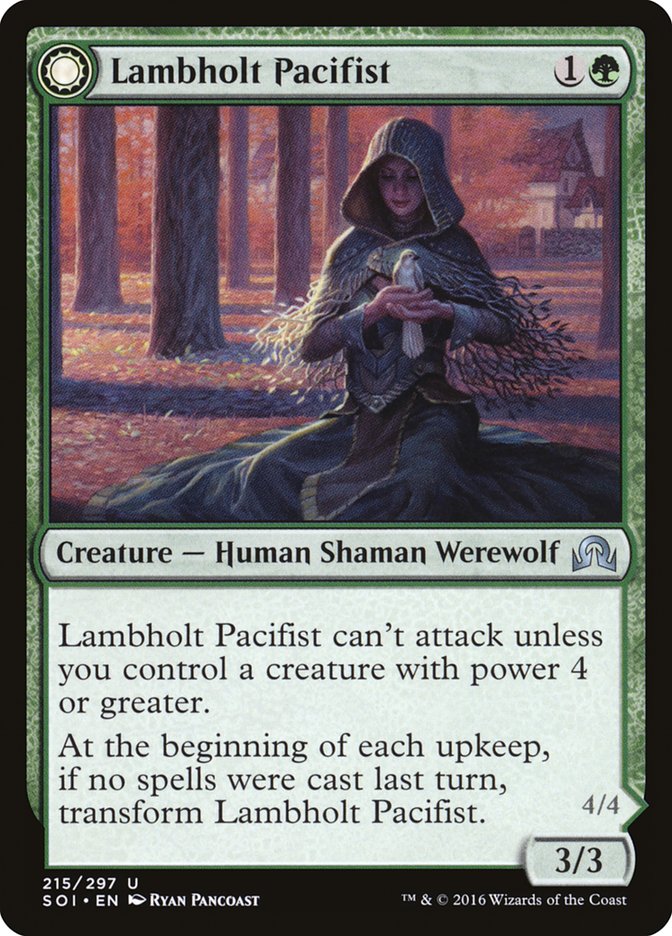Spoilers for Aether Revolt are upon us! With just the few cards that the Internet has decided to grace us with, it’s hard not to be excited with everything that is to come. As of writing this article, only fourteen cards have made their way to the StarCityGames.com preorder page and just about every single one of them has the potential to play a role a format-defining deck.
I’m only here for one of them.
Wow.
Oath of Ajani is a card that I look at and see so many possibilities that it’s hard to think of a single archetype that will benefit the most from it and its effects.
I’m not one to just recite card text as a means of justification, but seriously, both effects on this card are worth giving several looks. Card are only as powerful as the context of the format and decks that they’re surrounded by, and the versatility of Oath of Ajani raises the chances that it settles into a popular archetype.
Anthems
“When Oath of Ajani enters the battlefield, put a +1/+1 counter on each creature you control.”
This mode is relatively easy to evaluate because we have a similar effect in Standard:
There are naturally a few differences between the two cards, the most notable of which is that Thalia’s Lieutenant is going to be more powerful with the caveat of being significantly narrower than the no-power, no-toughness Oath.
The fact that Oath of Ajani is a pseudo-Anthem with a wider range is incredibly attractive. For those who might’ve missed it, I’m a strong advocate for -4’ing a Gideon, Ally of Zendikar the turn he enters the battlefield, and my forays with Standard W/U Flash have always involved Always Watching in the maindeck.
Creatures (19)
Planeswalkers (4)
Lands (25)
Spells (12)

While Oath of Ajani isn’t going to play exactly the same as Thalia’s Lieutenant, Always Watching, or Gideon, Ally of Zendikar, what it does have the ability to do is provide a redundancy of these effects for the decks that need them…
Creatures (23)
- 2 Expedition Envoy
- 4 Thraben Inspector
- 4 Thalia's Lieutenant
- 3 Tireless Tracker
- 4 Duskwatch Recruiter
- 2 Thalia, Heretic Cathar
- 4 Heron's Grace Champion
Lands (25)
Spells (12)

Craig Wescoe has always been an advocate of the low-to-the-ground white creature decks and this is a relatively natural fit for Oath of Ajani. The copies of Servant of the Conduit out of the board are in order to crank Gideon, Ally of Zendikar out as quickly as possible against decks where a four-mana indestructible 5/5 is necessary to race. Oath of Ajani accomplishes a similar goal, while presumably adding more power and toughness to the battlefield than Servant of the Conduit.
Oath of Ajani would lend itself to a lower-to-the-ground approach to the deck that was more one-drop-centric so the Oath could contribute as much damage to the battlefield as possible.
Creatures (22)
- 4 Expedition Envoy
- 4 Thraben Inspector
- 4 Thalia's Lieutenant
- 4 Hanweir Militia Captain
- 4 Town Gossipmonger
- 2 Thalia, Heretic Cathar
Lands (22)
Spells (12)

This take on the deck is most interested in trying to goldfish the opponent and get them dead as quickly as possible. The copies of Heron’s Grace Champion being omitted were quite intentional.
At the beginning of a format, it is generally correct to try to be as proactive as possible; it’s nigh-impossible to determine what decks people will sleeve up for early tournaments, and at the very least, a proactive deck will successfully be able to kill people if they stumble.
When updating this list, it wouldn’t be remotely shocking for some number of one-drops to be shaved in lieu of cards that interact better with the answers that people are bringing to the table.
Cost Reduction
“Planeswalker spells you cast cost 1 less to cast.”
Tempo is one of the most important things in modern-day Magic. On Premium,Brad Nelson briefly touched on cards like Rampant Growth being considered too powerful for Standard, but in a deck chock-full of planeswalkers, Oath of Ajani does a pretty great impression of one of the Tempest-era Medallions.
Wescoe’s deck tapped into the power of a cranking out Gideon, Ally of Zendikar ahead of schedule, but can that be pushed further?
Creatures (13)
- 4 Thraben Inspector
- 1 Sigarda, Heron's Grace
- 2 Tireless Tracker
- 2 Gisela, the Broken Blade
- 4 Servant of the Conduit
Planeswalkers (7)
Lands (25)
Spells (15)

This deck focuses on the sort of two-mana into (effective) four-mana plan that many ramp strategies over the last few years have gravitated towards.
With another powerful four-mana green planeswalker, it wouldn’t be too hard to justify Deathcap Cultivator’s inclusion in the deck. The biggest reason for his omission here is his inability to produce white mana makes him a little shaky at casting a spell that costs double white as well as two generic mana.
The biggest detractor from Oath of Ajani in this shell is that the first ability isn’t utilized in a way that makes redundant copies of the Aether Revolt newcomer worth an entire card. This issue can draw parallels to Oath of Chandra’s thus-far lack of residency in the format: outside of Oath of Chandra doing a Spellskite impression to protect Demonic Pact from Dromoka’s Command, the Firebrand’s promise hasn’t put up nearly the results that its counterparts have.
Without drawing a copy of Gideon, Ally of Zendikar, it’s relatively hard to imagine this deck looking like much more than a pile of acceptable white and green cards rather than a cohesive deck.
Several of the cards have a similar look to them, perhaps a previously successful archetype:
Creatures (16)
Planeswalkers (8)
Lands (25)
Spells (11)

Against a number of strategies, going wide via tokens and then going tall via Anthems is going to win a number of games just through the card advantage that Gideon and Nissa will generate in a single game. Oath of Ajani helps the deck have a more aggressive slant that it tended to lack in a format full of seven-mana 13/13 Mindslavers.
If trying to make a planeswalker deck more aggressive, there’s a certain Vehicle being printed in Aether Revolt that could be made use of:
Previous iterations of G/W Tokens sought to leverage the advantage of the planeswalkers in the form of card advantage via token generation. Hangarback Walker played to that strength incredibly and would frequently be used in conjunction with Evolutionary Leap and Gideon/Nissa minuses to provide an insurmountable amount of power from seemingly nothing.
Heart of Kiran can provide a similar angle of attack to the deck, but at a different phase of the game. When building the deck with Heart of Kiran in mind, the card becomes incredibly easy to attack with on the third turn of the game.
Outside of Nissa, Voice of Zendikar being able to protect itself, crew Heart of Kiran, and break even on loyalty on the third turn, there are creatures that make crewing the Heart easier than one would normally expect; perhaps it’s time for Lambholt Pacifist to come back to play?
Lambholt Pacifist hasn’t seen much play since Bant Company was Standard’s top dog, but she seems to be another angle of attack for a deck that wants to play the role of the aggro-slanted midrange deck. With Oath of Ajani; Nissa, Voice of Zendikar; and Gideon, Ally of Zendikar in the deck, it’s easy to make the Lambholt Pacifist have four power on her own, and that doesn’t even factor the possibility of animating Heart of Kiran, Gideon’s +1, or Lambholt Butcher coming out to play.
This is where I plan to start my playtesting for #SCGCOL next month:
Creatures (13)
Planeswalkers (8)
Lands (25)
Spells (14)

This decklist is a product of The Domino Effect. A good chunk of the cards in the deck are a result of their interactions with other cogs in the machine; it can be hard to determine if this is a case of synergistic deckbuilding or using cards to justify one another.
The low number of hits for Oath of Nissa may cause the deck to need an entire rework from the ground up. The card selection it provides is integral to a deck that needs a few different pieces to function, in this case creatures, planeswalkers, and enough lands to cast all of them. It may sound like an easy mix to find off the top of one’s library, but finding only creatures will likely be too weak to compete with other strategies, and even planeswalkers as powerful as Gideon and Nissa have trouble protecting themselves on their own.
Perhaps being a more dedicated midrange deck is the answer?
Creatures (12)
Planeswalkers (11)
Lands (26)
Spells (11)

Rather than trying to imitate an aggressive deck, the Naya version of the Planeswalkers deck focuses more on winning the grindy midrange battles that can happen in-game. The biggest issue I can foresee with this deck is answering the Emrakuls that follow the first copy of the Eldrazi Titan. Digging up a Stasis Snare or Ajani Unyielding to answer the first Emrakul isn’t too much of an issue. What about the following copies?
This list has been tuned with that in mind, featuring as few cards as possible that can backfire. Naturally the opponent has the ability to -4 Gideon in order to finish him off, but Stasis Snare can’t target your own creatures, and the other planeswalkers generally take multiple activations to get off of the battlefield. Mitigating the power of Mindslaver through this deckbuilding concession (and the Sigarda, Heron’s Graces in the deck) is likely the best answer to the one-eyed flying purple people eater.
Despite all of the decks with both Gideon and Nissa having a hefty number of cards in common, the cards that fill in the cracks tend to dictate the pace that the deck itself will operate. Oath of Ajani’s ability to fit in with the aggressive one-drop Humans deck as well as the ten-plus Planeswalkers deck makes me incredibly optimistic about the card. It’s literally the only card from Aether Revolt that I’ve preordered so far, and I’m more than a little confident in that decision.
The biggest drawback I tend to associate with a new, versatile, and clearly abusable card is that there may not be enough time to find the best home for Oath of Ajani before it’s time to submit decks for the inaugural SCG Tour event of next year.
I just hope that it’s not another Emrakul deck…





